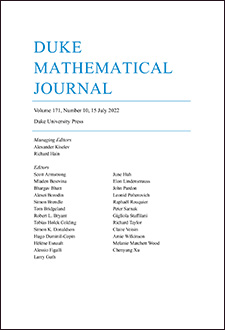Abstract
We prove lower bounds for energy in the Gaussian core model, in which point particles interact via a Gaussian potential. Under the potential function with , we show that no point configuration in of density can have energy less than as with and fixed. This lower bound asymptotically matches the upper bound of obtained as the expectation in the Siegel mean value theorem, and it is attained by random lattices. The proof is based on the linear programming bound, and it uses an interpolation construction analogous to those used for the Beurling–Selberg extremal problem in analytic number theory. In the other direction, we prove that the upper bound of is no longer asymptotically sharp when . As a consequence of our results, we obtain bounds in for the minimal energy under inverse power laws with , and these bounds are sharp to within a constant factor as with fixed.
Citation
Henry Cohn. Matthew de Courcy-Ireland. "The Gaussian core model in high dimensions." Duke Math. J. 167 (13) 2417 - 2455, 15 September 2018. https://doi.org/10.1215/00127094-2018-0018
Information





